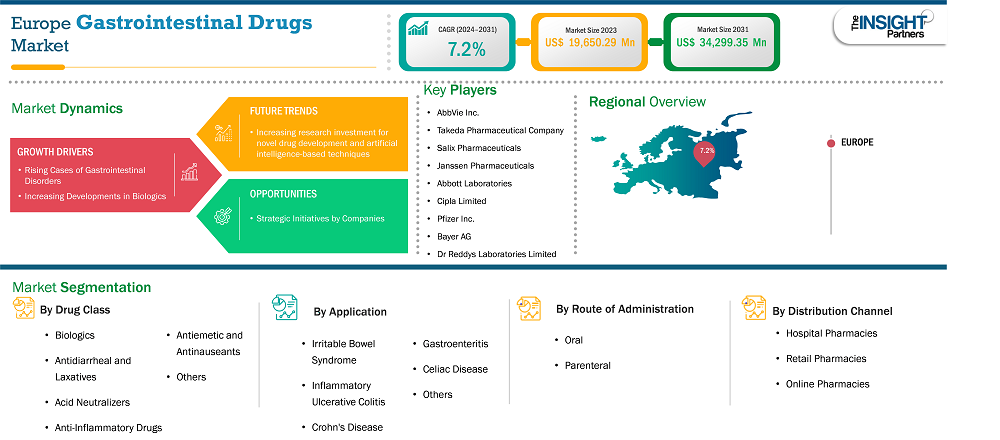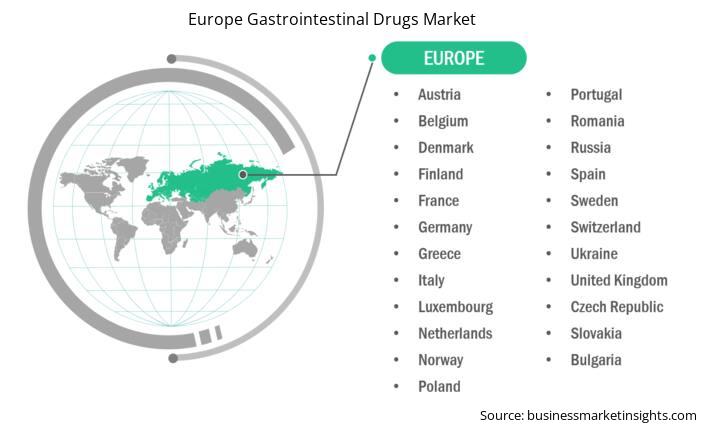Europe Gastrointestinal Drugs Market Report (2021-2031) by Scope, Segmentation, Dynamics, and Competitive Analysis
No. of Pages: 165 | Report Code: TIPRE00016280 | Category: Life Sciences
No. of Pages: 165 | Report Code: TIPRE00016280 | Category: Life Sciences
The Europe gastrointestinal drugs market size is expected to reach US$ 34,299.35 million by 2031 from US$ 19,650.29 million in 2023. The market is estimated to record a CAGR of 7.2% from 2023 to 2031.
The Europe gastrointestinal drugs market is segmented into Germany, the UK, France, Italy, Spain, and the Rest of Europe. The market growth in the region is attributed to the rising prevalence of gastrointestinal disorders such as IBD and IBS, along with a surge in research and development activities, leading to the innovation of advanced therapeutics for the treatment of various gastrointestinal conditions.

Key segments that contributed to the derivation of the gastrointestinal drugs market analysis are drug class, application, route of administration, and distribution channel.
Gastrointestinal diseases are conditions that occur in the gastrointestinal tract. Common digestive problems include heartburn, inflammatory bowel diseases (IBD), inflammatory bowel syndrome (IBS), gastroenteritis, gastroesophageal reflux disease (GERD), constipation, diarrhea, etc. Gastrointestinal diseases are common chronic inflammatory conditions that affect an enormous population worldwide. This is due to a sedentary lifestyle, changing dietary habits, and stress, among other factors. Also, the incidence and prevalence of gastrointestinal diseases are higher in adults, and as the population ages, the disease burden is also expected to increase.
According to the study, “Gastroesophageal Reflux Disease,” published in July 2023, GERD is one of the most prevalent diagnosed gastrointestinal conditions, affecting 20% of the people, resulting in major economic burden in direct and indirect costs and adversely impacting the quality of life.
Europe is also experiencing a growing number of chronic digestive diseases due to the aging population and lifestyle factors such as a surge in obesity cases and high alcohol consumption. According to the European Federation of Crohn's & Ulcerative Colitis Associations, ~10 million individuals are suffering from IBD worldwide. Research conducted by Crohn’s & Colitis UK in 2022 indicates that 1 in every 123 people are either diagnosed with Crohn’s disease or ulcerative colitis in the UK, representing a total of half a million people in the country suffering from IBD.
Furthermore, the incidence and prevalence of IBS have increased in the last few decades globally. As per the International Foundation for Gastrointestinal Disorders, Inc., IBS is the most prevalent functional gastrointestinal disease, with a prevalence rate of 10–15% of the population across the globe. A study conducted by the University of Gothenburg states that for every ten adults in the world, four suffer from functional gastrointestinal disorders of varying severity. In the US, there are approximately 2.4–3.5 million hospital visits for IBS annually. Thus, the rising prevalence of gastrointestinal diseases worldwide fuels the demand for treatment of these conditions, thereby driving the gastrointestinal drugs market.
Based on country, the Europe gastrointestinal drugs market comprises Germany, the UK, France, Italy, Spain, and the Rest of Europe. Germany held the largest share in 2023.
Germany is an attractive market for gastrointestinal drugs market due to the increasing prevalence of gastrointestinal infections and disorders. As per the article published by Deutsches Ärzteblatt 2023, the prevalence of inflammatory bowel disease is rapidly increasing and affecting 0.7% of the German population or 600,000 patients in Germany. Additionally, as per a medRxiv article published in 2023, Gastrointestinal infections account for 24.5 million outpatient visits annually in Germany. Moreover, the surging development of effective treatment options by various market players led to innovative product developments and clinical trials, along with the increasing geriatric population prone to gastrointestinal issues, are contributing to the market growth. For instance, in October 2021, Renexxion Ireland Ltd. collaborated with Dr. Falk Pharma GmbH for the development and commercialization of Naronapride, a unique late-stage GI prokinetic, initially for gastroparesis. Furthermore, Germany is Europe’s largest pharmaceutical market, and constant expansion in the coming years is expected to be a major contributor to the market growth. As per the Germany Trade and Invest, Germany's pharmaceutical production volume reached US$ 38.03 billion by the end of 2021, with a growth rate of 6.9% per year. In addition, Germany has invested US$ 9.56 billion in research and development, with 589 clinical trials in 2021, ranking second in Europe and sixth worldwide. Therefore, all the above-discussed factors are expected to fuel the growth of the gastrointestinal drugs market in Germany during the forecast period.
| Report Attribute | Details |
|---|---|
| Market size in 2023 | US$ 19,650.29 Million |
| Market Size by 2031 | US$ 34,299.35 Million |
| CAGR (2023 - 2031) | 7.2% |
| Historical Data | 2021-2022 |
| Forecast period | 2024-2031 |
| Segments Covered |
By Drug Class
|
| Regions and Countries Covered | Europe
|
| Market leaders and key company profiles |
|
Some of the key players operating in the gastrointestinal drugs market include Sanofi SA, GSK Plc, Johnson & Johnson, Bausch Health Companies Inc, AstraZeneca Plc, Takeda Pharmaceutical Co Ltd, AbbVie Inc, Bayer AG, and Pfizer Inc among others. These players are adopting various strategies such as expansion, product innovation, and mergers and acquisitions to provide innovative products to their consumers and increase their market share.
The following methodology has been followed for the collection and analysis of data presented in this report:
The research process begins with comprehensive secondary research, utilizing both internal and external sources to gather qualitative and quantitative data for each market. Commonly referenced secondary research sources include, but are not limited to:
Note: All financial data included in the Company Profiles section has been standardized to USD. For companies reporting in other currencies, figures have been converted to USD using the relevant exchange rates for the corresponding year.
The Insight Partners’ conducts a significant number of primary interviews each year with industry stakeholders and experts to validate its data analysis, and gain valuable insights. These research interviews are designed to:
Primary research is conducted via email interactions and telephone interviews, encompassing various markets, categories, segments, and sub-segments across different regions. Participants typically include:

The Europe Gastrointestinal Drugs Market is valued at US$ 19,650.29 Million in 2023, it is projected to reach US$ 34,299.35 Million by 2031.
As per our report Europe Gastrointestinal Drugs Market, the market size is valued at US$ 19,650.29 Million in 2023, projecting it to reach US$ 34,299.35 Million by 2031. This translates to a CAGR of approximately 7.2% during the forecast period.
The Europe Gastrointestinal Drugs Market report typically cover these key segments-
The historic period, base year, and forecast period can vary slightly depending on the specific market research report. However, for the Europe Gastrointestinal Drugs Market report:
The Europe Gastrointestinal Drugs Market is populated by several key players, each contributing to its growth and innovation. Some of the major players include:
The Europe Gastrointestinal Drugs Market report is valuable for diverse stakeholders, including:
Essentially, anyone involved in or considering involvement in the Europe Gastrointestinal Drugs Market value chain can benefit from the information contained in a comprehensive market report.